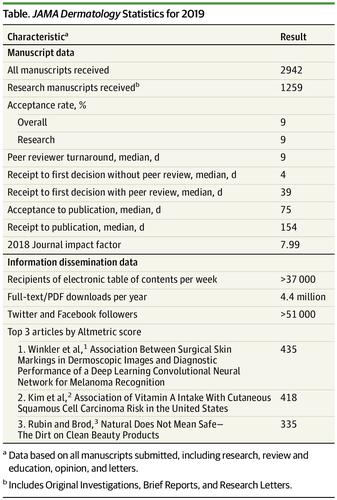JAMA Dermatology ( IF 11.5 ) Pub Date : 2020-05-01 , DOI: 10.1001/jamadermatol.2019.4076 Kanade Shinkai 1, 2

|
JAMA Dermatology continued to thrive in 2019, maintaining an impact factor of 7.99 and our high rank among all dermatology journals. Manuscript submissions rose; the journal received 2942 submissions in the past year, an increase from 2584 in 2018 and 2153 in the prior year (Table). In 2019, 1259 of 2942 submissions (42.8%) were reports of research, including Original Investigations, Brief Reports, and Research Letters. A total of 9% of submissions overall were accepted, reduced from a 14% acceptance rate during the previous year. Reducing the time to publication continues to be an ongoing priority and area for improvement for the journal, with a median reviewer turnaround time of 9 days, median receipt to rejection time of 4 days, and median time from acceptance to publication of 75 days. The editorial leadership team continues to strive to find ways to improve the authors’ experience to ensure authors the fastest and best publication of their work.
The journal continued to have broad digital reach, with 4.4 million full-text views and PDF downloads in the past year, and connecting with a growing number of followers (more than 51 000) on social media channels Twitter and Facebook. JAMA Dermatology was pleased to be involved in the JAMA Network’s arrival on Instagram (@jamanetwork), as we predict that our visual-based content will thrive in that space. The journal received 3700 media mentions this year, another important indicator of the journal’s success. Three JAMA Dermatology articles were among the Altmetric top-scoring dermatology articles in 2019, including 2 Original Investigations titled “Association Between Surgical Skin Markings in Dermoscopic Images and Diagnostic Performance of a Deep Learning Convolutional Neural Network for Melanoma Recognition”1 and “Association of Vitamin A Intake With Cutaneous Squamous Cell Carcinoma Risk in the United States”2 as well as an Editorial titled “Natural Does Not Mean Safe—The Dirt on Clean Beauty Products.”3 The popularity of the first study is striking, as it is a highly technical computational article. What is the significance of this well-deserved attention? Machine learning is undoubtedly here to stay and likely in time will be a valuable commonplace tool to augment our abilities to provide expert care for cutaneous disease. This work by Winkler et al1 highlights that it is essential to rigorously evaluate the algorithms used to train machines to detect skin lesions in images, as seemingly innocuous elements—in this case surgical pen markings intended to identify a skin lesion of concern—may significantly depreciate the computer’s accuracy. Improved understanding of when machine learning can improve or impede clinical practice, as well as the road to achieving this improved understanding, is thoughtfully discussed in the accompanying Editorial.4
It is a journal priority to feature important research that informs and changes the clinical practice of dermatologists. In 2019, new information about adverse psychiatric effects of isotretinoin,5 the use of novel agents for common diseases, such as atopic dermatitis,6,7 strategies to predict clinical response to medications, including an early foray into personalized medicine in dermatology8 and opioid use in patients with hidradenitis suppurativa9 were featured. The journal also highlighted vital self-reflections for our specialty, such as antibiotic stewardship,10 quality improvement,11 the use of Mohs micrographic surgery for invasive melanoma,12 and the rapid rise of private equity acquisition of dermatology practices.13
中文翻译:

JAMA皮肤病学-年度回顾,2019年。
牙买加皮肤科继续在2019年蓬勃发展,影响因子保持在7.99,在所有皮肤病学期刊中我们都排名很高。手稿的提交增加了。该期刊在过去一年中收到2942份投稿,较2018年的2584份和上一年的2153份有所增加(表)。2019年,在2942份申请中,有1259份(42.8%)是研究报告,包括原始调查,简要报告和研究信。总体上,共有9%的提交被接受,而上一年的接受率为14%。减少出版时间仍然是该期刊的工作重点和改进领域,审阅者的中位周转时间为9天,收货到拒绝的中位时间为4天,从接受到出版的中位时间为75天。
该杂志继续拥有广泛的数字影响,在过去的一年中,该杂志的全文浏览量和PDF下载量达到了440万,并且在社交媒体频道Twitter和Facebook上与越来越多的关注者(超过51000)建立了联系。JAMA皮肤科很高兴参与JAMA Network的Instagram(@jamanetwork)的发布,因为我们预测基于视觉的内容将在该领域蓬勃发展。该期刊今年获得3700篇媒体提及,这是该期刊成功的另一个重要指标。三种JAMA皮肤科这些文章是2019年Altmetric得分最高的皮肤病学文章之一,包括2项原始研究,题为``皮肤镜图像中的手术皮肤标记与深度学习卷积神经网络对黑素瘤识别的诊断性能之间的关联'' 1和``维生素A摄入与美国的皮肤鳞状细胞癌风险” 2和标题为“天然并不意味着安全-清洁美容产品上的污垢”的社论。3第一项研究的受欢迎程度令人震惊,因为它是一篇技术性很强的计算文章。这个当之无愧的关注有什么意义?毫无疑问,机器学习将一直保留下去,并且很可能会及时成为一种有价值的普通工具,以增强我们为皮肤疾病提供专家护理的能力。Winkler等人的这项工作1强调必须严格评估用于训练机器以检测图像中的皮肤病变的算法,因为看似无害的元素(在这种情况下,是旨在识别关注的皮肤病变的手术笔标记)可能会大大降低计算机的准确性。在随附的社论中,对如何更好地理解机器学习何时可以改善或阻碍临床实践以及达到这种更好理解的途径进行了深思熟虑的讨论。4
重要的研究能够为皮肤科医生提供信息并改变其临床实践,这是期刊的工作重点。在2019年,约异维A酸的不良精神病效应的新信息,5使用常见疾病的新试剂,如特应性皮炎,的6 ,7个策略来预测临床响应于药物,包括早期进军个性化药物在皮肤科8和阿片样物质在化脓性汗腺炎患者中使用9是特色。该期刊还强调了我们专业的重要自我反思,例如抗生素管理,10项质量改进,11莫氏显微摄影术用于浸润性黑色素瘤的治疗12。以及私募股权收购皮肤病学实践的迅速兴起。13









































 京公网安备 11010802027423号
京公网安备 11010802027423号